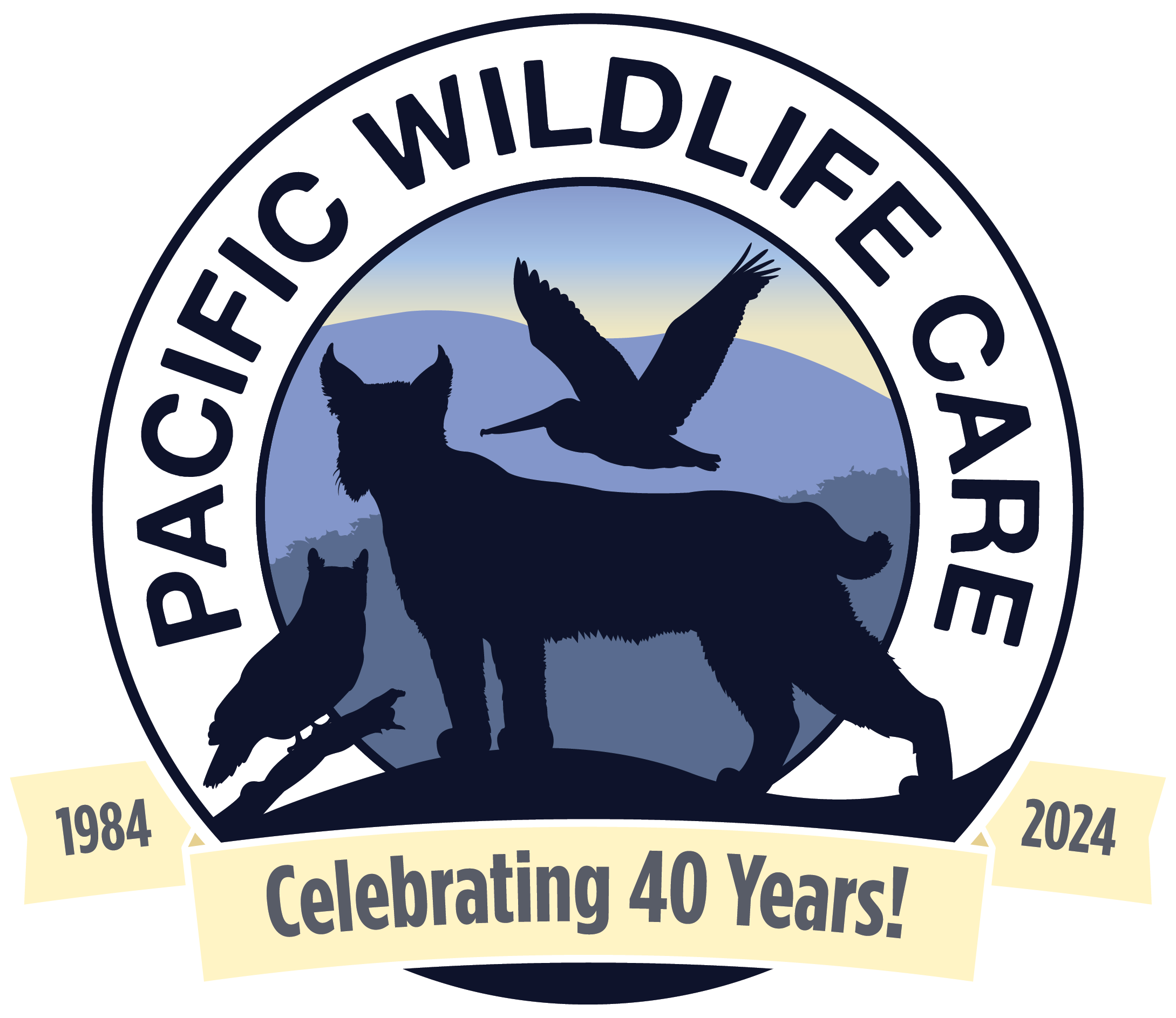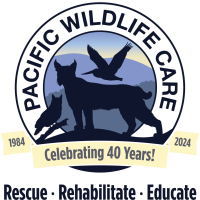Help Us Build a Forever Home for Wildlife!
Pacific Wildlife Care is thrilled to announce our plans for a new, permanent home in San Luis Obispo. Located on a beautiful 10-acre property, the Kim and Derrel Ridenour Wildlife Rehabilitation Center will enable us to better serve our community’s wildlife. Our comprehensive goal of $11.5 million will secure funding needed for the construction of this transformational project and create a sustainable future for PWC. Thanks to the generosity of our supporters, we’ve raised $5.7 million towards the $7 million needed for initial planning and construction needs. Additionally we have raised $3.8 million in legacy gifts to help create a sustainable future for PWC.
With construction starting in early 2025, your support is vital. Donate today to help us create a brighter future for wildlife in San Luis Obispo County.
Behind the Scenes at PWC
Pacific Wildlife Care (PWC) has been an advocate for wildlife in San Luis Obispo County since 1984.
From that time we have grown from a small group of dedicated home rehabilitators into a successful non-profit organization with a well-equipped rehabilitation center, a full-time wildlife veterinarian, a small paid staff, and nearly 200 volunteers. In addition to the Rehabilitation Center, which is open every day of the year, we maintain a Wildlife Hotline that the public can call to report distressed wildlife (injured, sick, orphaned) and to receive information about our local wildlife.









Facebook Posts
Yesterday, we shared a post about the differences between ravens and crows— today, you get to see one of these birds in action! Meet Corax, our incredible ambassador Common Raven, who is hard at work solving his puzzle feeder! This clever raven has a wing injury that prevents him from thriving in the wild. Now, he helps us educate the public about the intelligence and importance of ravens in our ecosystems.
Ravens are some of the smartest animals in the world, rivaling primates in problem-solving abilities. To keep Corax mentally and physically stimulated, we provide him with enrichment activities like puzzle feeders, which mimic the challenges he would face foraging in the wild. Watch as he uses his sharp mind and nimble beak to access his meal.
It’s important to remember that while Corax is fascinating to observe, he is not a pet. Ravens and other wild animals have complex needs that are impossible to meet in a home environment. Corax’s care requires expertise, permits, routine vet care from a wildlife vet, and daily enrichment to ensure his well-being.
By watching Corax in action, we hope you’ll gain a greater appreciation for the incredible intelligence of ravens and the vital role they play in our ecosystems. You can help protect ravens in the wild by keeping their habitats clean from trash, avoiding the use of harmful pesticides, and respecting their nesting areas.
#raven #educationalambassador #wildlife ... See MoreSee Less
👀 Can you tell the difference between crows and ravens? In SLO County, we frequently see both American Crows and Common Ravens – here’s how you can spot the differences!
◾ American Crows are smaller in size, with a smaller bill. They are highly social and often seen in large flocks (sometimes even in the thousands!). In flight, note their fan-shaped tail and rapid wingbeats. If you hear the distinctive and familiar “caw” sound, that’s an American Crow!
◾ Common Ravens are larger, with a longer, thicker bill. In flight, they show their diamond or wedge-shaped tail and have smooth, steady wingbeats. They are often seen alone, in a pair, or in a small group. Common Ravens make a variety of interesting sounds, including a loud croak.
🧠 Crows and ravens are closely related and are well-known for their clever use of tools and puzzle-solving to get to food. Studies have shown they recognize faces, hold grudges for generations, and even hold funerals. They are omnivores and eat almost anything, including nuts and seeds, small animals like mice and birds, and carrion. They serve an important role in our ecosystem by eating insect pests and distributing seeds!
You can help these birds and all wildlife by refraining from using rodenticides and pesticides. If you have unwanted crows in your yard, find safe solutions and make the area less attractive to them by securing trash, covering compost, and feeding pets inside.
☎️ If you find an injured crow or raven in SLO County, please call us (remember, it’s illegal to keep these birds, even if you plan to release them later)!
#AmericanCrow #CommonRaven #Crow #Raven #Wildlife #BirdFacts ... See MoreSee Less
🚩 Reminder – please do not use glue traps!
Unfortunately, we have seen a recent influx of animals brought to PWC stuck to glue traps. These sticky boards, sold for rodent control, are inhumane and indiscriminate. Glue traps don’t instantly kill the animal but instead cause a slow, painful death by starvation, dehydration, or suffocation.
In addition to rodents, we see unintended victims like songbirds, lizards, snakes, and bats caught in these traps. Stuck animals struggle and become even more ensnared, often losing fur, feathers, or skin, and may break their bones in their attempt to escape.
There is currently a bill in congress that would BAN glue traps nation-wide! There is still time for this bill to pass by the end of the legislative session – contact your representative and urge their support of H.R.7018 - The Glue Trap Prohibition Act of 2024! Learn about the bill here: congress.gov/bill/118th-congress/house-bill/7018/all-actions
If you find an animal stuck to a glue trap, please do NOT try to remove the animal yourself. Instead:
1️⃣ Cover the sticky area with tissue, flour, or another non-toxic material to keep the animal from getting stuck further.
2️⃣ Place the animal and the trap in a warm, dark box.
3️⃣ Take to a wildlife rehabilitator as soon as possible—our trained professionals have the tools and skills needed to free the animal and maximize its chances of recovery.
🐀 Prevent rodents from becoming a problem by eliminating yard waste and securing all trash and food sources. Exclude rodents from inside your house by sealing openings 1/4 inch or larger. If you have rodents in your home, use a live trap to safely move rodents from inside to outside, or use lethal control like an electronic trap. Never use poisons or glue traps. Remember, rodents are a natural part of the outside ecosystem – traps of any kind should NEVER be placed OUTSIDE. Find more at raptorsarethesolution.org
Help us spread the word – please share this message with friends and neighbors to help keep wildlife safe!
#BanGlueTraps #GlueTraps #ProtectWildlife #WildlifeRehab ... See MoreSee Less
📢 Have you heard the news? Pacific Wildlife Care is growing! 🎉
We are excited to share that we will be building and moving to a new facility on a 10-acre site in San Luis Obispo, at the northwest corner of Buckley Road and Esperanza Lane. This multi-phased project will result in 18,000 sq ft of building space, including 9,900 sq ft of exterior animal enclosures. We aim to break ground early next year!
“The new Kim and Derrel Ridenour Wildlife Rehabilitation Center will not only increase our capacity to meet the needs of wildlife in SLO County but also provide a permanent home for PWC,” says Kristin Howland, PWC Executive Director. “This facility embodies our commitment to wildlife rehabilitation and reflects our vision for the future.”
Please join us by supporting the new facility and our ongoing operations. Click the donate button below or visit us at pacificwildlifecare.networkforgood.com/projects/184151-capital-campaign. Your generous contributions, no matter the size, directly support wildlife in need.
Together, we can build a brighter future for wildlife 💚
#pacificwildlifecare #wildliferehab #supportnonprofits ... See MoreSee Less